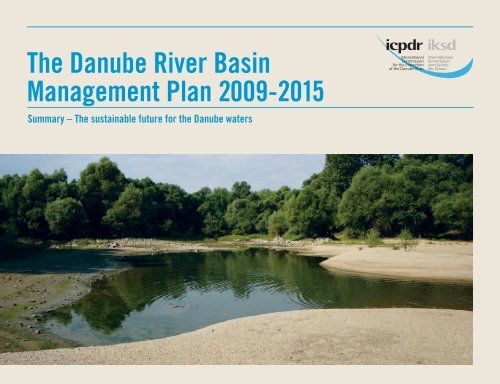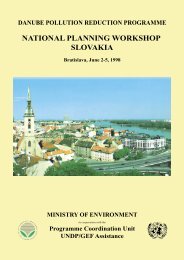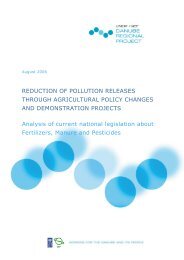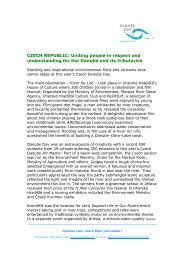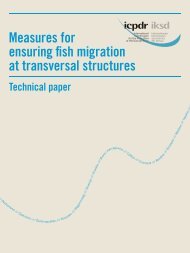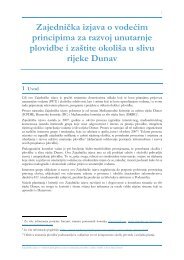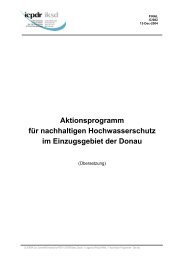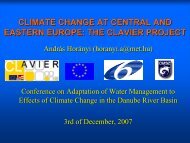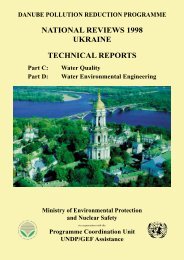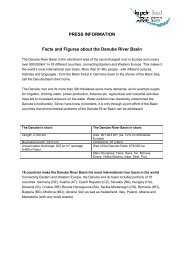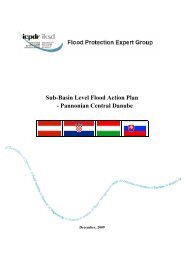The Danube River Basin Management Plan 2009-2015 - ICPDR
The Danube River Basin Management Plan 2009-2015 - ICPDR
The Danube River Basin Management Plan 2009-2015 - ICPDR
You also want an ePaper? Increase the reach of your titles
YUMPU automatically turns print PDFs into web optimized ePapers that Google loves.
<strong>The</strong> <strong>Danube</strong> <strong>River</strong> <strong>Basin</strong><br />
<strong>Management</strong> <strong>Plan</strong> <strong>2009</strong>-<strong>2015</strong><br />
Summary – <strong>The</strong> sustainable future for the <strong>Danube</strong> waters
“In 1994, we set out on our voyage of<br />
international respect and cooperation.<br />
We first had to work out where we were<br />
and what it was like. With the publication<br />
of the <strong>Danube</strong> <strong>River</strong> <strong>Basin</strong> <strong>Management</strong><br />
<strong>Plan</strong> in <strong>2009</strong>, we now also know exactly<br />
where we are going and how to get there.<br />
This is a major landmark on our journey<br />
to a sustainable <strong>Danube</strong> <strong>Basin</strong>.”<br />
Mitja Bricelj, Secretary of the Ministry of Environment and Spatial <strong>Plan</strong>ning of Slovenia and<br />
President of the International Commission for the Protection of the <strong>River</strong> <strong>Danube</strong> 2010<br />
3
Naab<br />
<strong>The</strong> <strong>Danube</strong> <strong>River</strong> <strong>Basin</strong> and the 15 contracting parties to the <strong>Danube</strong> <strong>River</strong> Protection Convention<br />
European Union<br />
European Commission, DG Environment<br />
www.ec.europa.eu/environment/<br />
Germany<br />
Federal Ministry for the Environment,<br />
Nature Conservation and Nuclear Safety<br />
www.bmu.de/<br />
Austria<br />
Ministry for Agriculture,<br />
Forestry, Environment<br />
and Water <strong>Management</strong><br />
www.lebensministerium.at/<br />
<strong>The</strong> <strong>Danube</strong> <strong>River</strong> <strong>Basin</strong> is the most international basin in the world. It includes the territories<br />
of 19 European countries, is home to 80 million people and comprises a globally<br />
important natural environment. Some 14 countries contain major <strong>Danube</strong> rivers, and with<br />
the addition of the European Union, make up the 15 signatories to the <strong>Danube</strong> <strong>River</strong><br />
Protection Convention (1994). <strong>The</strong> International Commission for the Protection of the<br />
<strong>Danube</strong> <strong>River</strong> (<strong>ICPDR</strong>) is the facilitating platform between the 15 contracting parties.<br />
Donau<br />
Slovenia<br />
Ministry of the Environment<br />
and Spatial <strong>Plan</strong>ning<br />
www.mop.gov.si/<br />
Czech Republic<br />
Ministry of the Environment<br />
www.env.cz/<br />
Main-Donau<br />
Kanal<br />
Croatia<br />
Ministry of Regional Development,<br />
Forestry and Water <strong>Management</strong><br />
www.mrrsvg.hr/<br />
Lech<br />
Inn<br />
Isar<br />
Inn<br />
Salzach<br />
A d r i a t i c<br />
S e a<br />
Traun<br />
Drau<br />
Mur<br />
Enns<br />
Donau<br />
Dyje<br />
Thaya<br />
Sava<br />
Kolpa<br />
Neusiedler<br />
See / Ferto-tó<br />
Raab<br />
Rabnitz<br />
Kupa<br />
Bosnia and Herzegovina<br />
Ministry of Foreign Trade<br />
and Economic Relations<br />
www.mvteo.gov.ba/<br />
Slovakia<br />
Ministry of Environment<br />
www.enviro.gov.sk/<br />
Svratka<br />
Una<br />
March<br />
Répce<br />
Una<br />
Dunaj<br />
Zala<br />
Mura<br />
Rábca<br />
Drava<br />
Sana<br />
Morava<br />
Rába<br />
Vrbas<br />
Nitra<br />
Balaton<br />
Sava<br />
Duna<br />
Bosna<br />
Sió<br />
Ipel'<br />
Ipoly<br />
Zagyva<br />
Slaná<br />
Kanal Dunav-<br />
Tisa-Dunav<br />
Montenegro<br />
Ministry of Agriculture, Forestry<br />
and Water <strong>Management</strong><br />
www.minpolj.gov.me/<br />
Váh<br />
Hron<br />
Hungary<br />
Ministry of<br />
Environment and Water<br />
www.kvvm.hu/<br />
Drina<br />
Drina<br />
Hornád<br />
Sajó<br />
Tisa<br />
Dunav<br />
Hernád<br />
Tisza-tó<br />
Lim<br />
Hármas<br />
Körös<br />
Maros<br />
Sava<br />
Hortobágy-Berettyó<br />
Laborec<br />
Bodrog<br />
Tisza<br />
Berettyó<br />
Sebes-Körös<br />
Kettos-Körös<br />
Plovni Begej<br />
Tamiš<br />
Zapadna Morava<br />
Ibar<br />
Latorica<br />
Szamos<br />
Velika Morava<br />
Barcau<br />
Južna Morava<br />
Tysa<br />
Somes<br />
Crisul Repede<br />
Crisul Negru<br />
Crisul Alb<br />
Bega<br />
Timis<br />
Timok<br />
Tisa<br />
Somesul Mic<br />
Nišava<br />
Mures<br />
Somesul Mare<br />
Jiu<br />
Ogosta<br />
Nishava<br />
Romania<br />
Ministry of Environment and Forests<br />
www.mmediu.ro/<br />
Iskar<br />
Prut<br />
Mures<br />
Tarnava<br />
Ukraine<br />
Ministry for<br />
Environmental Protection<br />
www.menr.gov.ua/<br />
Olt<br />
Siret<br />
Vedea<br />
Jijia<br />
Moldova<br />
Bistrita<br />
Arges<br />
Dunav<br />
Olt<br />
Trotus<br />
Such a complex river system needed one of the most comprehensive water resource analyses<br />
ever attempted to map out a future for the water environment – one that addresses<br />
the needs of the people and nature of the region and in doing so meets the requirements<br />
of the EU Water Framework Directive (WFD). <strong>The</strong> <strong>Plan</strong> represents a huge step forward in the<br />
way in which we will safeguard and improve our water environment.<br />
Yantra<br />
Siret<br />
Ialomita<br />
Serbia<br />
Ministry of Agriculture, Forestry<br />
and Water <strong>Management</strong><br />
www.minpolj.gov.sr/<br />
Bârlad<br />
Buzau<br />
Prut<br />
Dunarea<br />
Ialpug<br />
Yalpug<br />
Kugurlui<br />
Kagul<br />
Lacul<br />
Razim<br />
Lacul<br />
Sinoie<br />
Canal Dunarea-<br />
Marea Neagra<br />
B l a c k<br />
S e a<br />
Moldova<br />
Ministry of Environment<br />
www.mediu.gov.md/<br />
Bulgaria<br />
Ministry of Environment<br />
and Water<br />
www.moew.government.bg/<br />
One of the most comprehensive river studies ever undertaken in the world …<br />
of the most international river basin in the world:<br />
<strong>The</strong> <strong>Danube</strong> <strong>River</strong> <strong>Basin</strong> <strong>Management</strong> <strong>Plan</strong><br />
Ambitious plans for an ambitious future<br />
Nine years in the planning, the <strong>Danube</strong> <strong>River</strong> <strong>Basin</strong> <strong>Management</strong> <strong>Plan</strong> (DRBM <strong>Plan</strong>) is<br />
one of the most comprehensive analyses ever attempted of the status and management<br />
options for a major river system. Involving over 200 experts from 14 countries and the<br />
EU, as well as hundreds of people living in the region, this is the document that will<br />
secure the future of the <strong>Danube</strong> rivers for future generations. It provides a detailed overview<br />
of the basin and sets out a Joint Programme of Measures, guiding activities across the<br />
25,117 km of investigated river network. Taking a source-to-sea approach, it facilitates<br />
the sustainable use of the <strong>Danube</strong>’s resources and addresses key requirements of the<br />
EU Water Framework Directive (WFD).<br />
<strong>The</strong> DRBM <strong>Plan</strong> was a particular challenge in a basin as large and diverse as the <strong>Danube</strong>.<br />
Its publication reflects the major effort made by the 15 contracting parties to the 1994<br />
<strong>Danube</strong> <strong>River</strong> Protection Convention, as well as the coordinating body, the International<br />
Commission for the Protection of the <strong>Danube</strong> <strong>River</strong> (<strong>ICPDR</strong>). Non EU countries, not<br />
bound by the WFD, agreed to work towards the Directive’s objectives so that the basin<br />
as a whole can implement those objectives. Enormous effort was needed to apply new<br />
sampling methods and classification systems. It has been a journey of cooperation, with<br />
every country focusing their inputs to achieve shared goals. In addition to the DRBM<br />
<strong>Plan</strong>, which provides a coordinated strategy for the basin as a whole, detailed National<br />
<strong>Management</strong> <strong>Plan</strong>s have been developed. Everyone benefits from a healthy water<br />
environment and the rivers of the <strong>Danube</strong> <strong>Basin</strong> are at the heart of the region’s economic,<br />
social and environmental well-being. Achieving the WFD goals will have the added<br />
benefit of safeguarding the environment’s ability to support economically important<br />
uses and supply clean drinking water. It will protect ecosystems, increase fish stocks<br />
(including endangered sturgeon populations) and contribute to sustainable transport,<br />
flood protection and our resilience to climate change. Drawing up the <strong>Plan</strong> is part of<br />
a long process, but arguably the most important stage, as it defines where we are now,<br />
where we need to go and how to get there. It maps out actions that will change the way<br />
we do things across the board … and for the better.<br />
<strong>The</strong> International Commission for the<br />
Protection of the <strong>Danube</strong> <strong>River</strong><br />
<strong>The</strong> <strong>ICPDR</strong> is the facilitating platform between the 15 contracting parties of the <strong>Danube</strong><br />
<strong>River</strong> Protection Convention (1994). It is charged with coordinating the conservation,<br />
improvement and rational use of <strong>Danube</strong> waters. With this ambitious remit, it’s the largest<br />
body for river basin management in Europe. It is made up of high level delegates from<br />
Austria, Bosnia and Herzegovina, Bulgaria, Croatia, the Czech Republic, Germany,<br />
Hungary, Moldova, Montenegro, Romania, Serbia, Slovakia, Slovenia, Ukraine and the<br />
European Union, plus technical, scientific and civil society representatives. It is responsible<br />
for coordinating work towards the WFD requirements at the basin level and has<br />
prepared the DRBM <strong>Plan</strong> as part of this. Working closely with contracting parties, the<br />
<strong>ICPDR</strong> has consulted extensively with land managers and users, business representatives,<br />
NGOs and other individuals with an interest in the water environment.<br />
“Adoption of the <strong>Danube</strong> <strong>River</strong> <strong>Basin</strong> <strong>Management</strong> <strong>Plan</strong> is an historical moment for all<br />
<strong>Danube</strong> countries and a very concrete contribution to an efficient EU <strong>Danube</strong> Region Strategy.”<br />
Philip Weller, Executive Secretary of the <strong>ICPDR</strong><br />
4 5
<strong>The</strong> EU Water Framework Directive (2000)<br />
With increasing threats to European waters, the EU has made water protection a major priority. <strong>The</strong> WFD is the most substantial piece of water legislation ever produced by the European<br />
Commission. It establishes, for the first time, a framework for the protection of all waters (rivers, lakes, estuaries, ground and coastal waters) and the ecosystems that depend on them.<br />
It aims to protect and enhance all water bodies 1 to the level of good status (ecological, chemical and quantitative – the latter referring to groundwater) by <strong>2015</strong>.<br />
Focusing on entire river basins, it requires the coordination of all aspects of water management via a <strong>River</strong> <strong>Basin</strong> <strong>Management</strong> <strong>Plan</strong> (reviewed every six years) with a Programme of<br />
Measures, consisting of policies, strategies and actions to allow all water bodies to achieve and maintain good status. Meaningful public participation and the integration of economic<br />
approaches are integral. <strong>The</strong> WFD is the major driver for achieving sustainable water management in the <strong>Danube</strong> <strong>Basin</strong> and across Europe for many years to come. <strong>The</strong> outcome will<br />
be a healthy environment that takes due account of environmental, economic and social considerations.<br />
1 A water body is defined as a discrete and significant element of surface water such as a distinct stretch of river or coastal water, a lake, reservoir, or a distinct volume of groundwater within an aquifer.<br />
Where we are now<br />
<strong>The</strong> ecological and chemical status of the rivers of the <strong>Danube</strong> <strong>Basin</strong><br />
Although many gaps and uncertainties exist, we now have<br />
a good picture of the condition of the entire <strong>Danube</strong> <strong>Basin</strong><br />
for the first time, based on national data, the <strong>ICPDR</strong>’s<br />
Trans national Monitoring Network (since 1996) and the<br />
Joint <strong>Danube</strong> Surveys (2001 and 2007).<br />
<strong>River</strong>s<br />
Some 39% (9,835 km) of the rivers of the <strong>Danube</strong> <strong>Basin</strong> have been designated as heavily<br />
modified, so much so that good ecological status cannot be achieved in these stretches.<br />
This includes 56% of the <strong>Danube</strong> <strong>River</strong> alone.<br />
Of the entire 25,117 km of the investigated river network, 22% (5,494 km) is of good<br />
ecological status/potential and 45% (11,180 km) of good chemical status (Where a<br />
water body has been heavily modified as a result of human activity, so much so that<br />
good ecological status cannot be achieved, an objective of good ecological potential<br />
is used). Some 53% is of moderate or worse ecological status/potential and 27% fails<br />
good chemical status.<br />
Lakes and coastal waters<br />
Of the six major lakes analysed (including Lakes Balaton, Jalpuk, Razim and Neusiedlersee),<br />
three achieved good ecological status and two good chemical status. None of the<br />
coastal areas achieved good status.<br />
Groundwater<br />
Of 11 transboundary groundwater bodies analysed, 8 were of good chemical status. One<br />
was found to be entirely of poor chemical status as were parts of a further two, all due to<br />
nitrate pollution. Nine bodies showed adequate water levels as regards abstraction levels<br />
(good quantitative status) and parts of the remaining two also met this standard.<br />
7
Ecological status and ecological potential<br />
for river water bodies in the <strong>Danube</strong> <strong>River</strong> <strong>Basin</strong><br />
indicated in length (km) and relation to total length of river water bodies<br />
Ecological status good<br />
or better 3,446 rkm (14%)<br />
Ecological potential good<br />
or better 2,048 rkm (8%)<br />
Ecological status moderate<br />
or worse 6,987 rkm (28%)<br />
Ecological potential moderate<br />
or worse 6,284 rkm (25%)<br />
No data EU Member States<br />
346 rkm (1%)<br />
No data Non EU Member<br />
States 6,006 rkm (24%)<br />
Chemical status of river water bodies in the <strong>Danube</strong> <strong>River</strong> <strong>Basin</strong><br />
indicated in length (km) and relation to total length of river water bodies<br />
Good 11,180 rkm (45%)<br />
Failing 6,815 rkm (27%)<br />
No data EU Member States<br />
1,116 rkm (4%)<br />
No data Non EU Member<br />
States 6,007 rkm (24%)<br />
Heavily modified water bodies (HMWB),<br />
artificial water bodies (AWB) and natural river water bodies<br />
indicated in length (km) and relation to total length of river water bodies<br />
Natural 10,617 rkm (42%)<br />
Provisional natural (Non EU<br />
Member States) 1,285 rkm (5%)<br />
HMWB 8,195 rkm (33%)<br />
Provisional HMWB (Non EU<br />
Member States) 1,640 rkm (7%)<br />
AWB 1,071 (4%)<br />
No designation (Non EU Member<br />
States) 2,309 (9%)<br />
Status classification for the <strong>Danube</strong> <strong>River</strong> represented as continuous bands<br />
Ecological status,<br />
Ecological potential<br />
(Risk assessment for<br />
Non EU Member States)<br />
Chemical status<br />
(Risk assessment for<br />
Non EU Member States)<br />
rkm 2,857 2,600 2,400 2,200 2,000 1,800 1,600 1,400 1,200 1,000 800 600 400 200 0<br />
Ecological status:<br />
High<br />
Good<br />
Moderate<br />
Poor<br />
Ecological potential:<br />
Good or better<br />
Moderate or worse<br />
Non EU Member States (risk assessment, worst case<br />
assessment based on 4 risk categories:<br />
1. Organic, 2. Nutrient, 3. Hazardous substances,<br />
4. Hydromorphological alterations):<br />
Not at risk<br />
Probably at risk<br />
Chemical status:<br />
Good<br />
Failing<br />
Non EU Member States (risk assessment):<br />
Not at risk<br />
Probably at risk<br />
At risk<br />
Bad<br />
At risk<br />
9
Organic pollution<br />
An excess of organic matter, emanating from untreated wastewater<br />
from communities, industry and agriculture, which can harm<br />
aquatic populations and water status.<br />
Hydromorphological alterations<br />
Changes to the natural course of rivers which interrupt river and habitat continuity,<br />
disconnect wetlands and change water quantity and flow conditions – with serious<br />
impacts for the <strong>Danube</strong> environment, water quality and fish now and in the future.<br />
Vision for organic pollution:<br />
Zero emissions of untreated wastewater into the basin’s rivers.<br />
Vision for river/habitat continuity:<br />
Balanced management of structural man-made changes so aquatic ecosystem functions<br />
holistically with all native species represented.<br />
Where we need to go… together<br />
<strong>The</strong> visions of the <strong>Danube</strong> <strong>River</strong> <strong>Basin</strong> <strong>Management</strong> <strong>Plan</strong><br />
Nutrient pollution<br />
High levels of nutrients (nitrogen and phosphorus) from inadequately treated<br />
waste water, agricultural practices, industry and transport result in eutrophication,<br />
where harmful growths of algae produce ‘dead zones’ in water bodies.<br />
Vision for nutrient pollution:<br />
Balanced management so neither the waters of the <strong>Danube</strong> <strong>Basin</strong> nor<br />
the Black Sea are threatened or affected by eutrophication.<br />
Vision for wetlands:<br />
Reconnection and restoration of wetlands throughout the <strong>Basin</strong>.<br />
Vision for water quantity and flow:<br />
<strong>The</strong> natural development and distribution of the aquatic ecosystem<br />
are not negatively influenced by altered water quantity and flow conditions.<br />
Vision for future infrastructure projects:<br />
Projects are conducted transparently using best environmental practices and best available<br />
techniques. Negative transboundary effects are fully prevented, mitigated or compensated.<br />
<strong>The</strong> EU WFD requires that all waters reach at least good status by <strong>2015</strong> (or at the latest by 2027). <strong>The</strong><br />
DRBM <strong>Plan</strong> focuses on the main transboundary problems, the Significant Water <strong>Management</strong> Issues, that<br />
can directly or indirectly affect the quality of rivers and lakes as well as transboundary groundwater bodies,<br />
namely pollution by organic substances, pollution by nutrients, pollution by hazardous substances and<br />
hydromorphological alterations. Based on the detailed picture we now have of the <strong>Danube</strong> <strong>Basin</strong> waters,<br />
the DRBM <strong>Plan</strong> outlines visions for each issue to achieve an improved and sustainable water environment.<br />
Hazardous substances<br />
Man-made chemicals, metals, oil and its compounds, pesticides and<br />
medications stemming from industry, storm water overflow, agricultural<br />
practices, mining operations and accidental pollution; often very persistent<br />
and harmful in low concentrations.<br />
Vision for hazardous substances pollution:<br />
No risk or threat to human health or the aquatic ecosystem.<br />
Groundwater<br />
A major drinking water source in most <strong>Danube</strong> countries, which requires protection<br />
from pollution and over-use.<br />
Vision for groundwater:<br />
Emissions of polluting substances do not cause any deterioration of groundwater quality.<br />
Water use is appropriately balanced and does not exceed the available resources.<br />
10 11
Working together:<br />
public participation and the DRBM <strong>Plan</strong><br />
Effective river basin management can only take place when the people who use the water<br />
resources are actively involved. <strong>The</strong> WFD requires Member States to encourage the<br />
active involvement of all interested parties, giving them the opportunity to influence the<br />
management of their waters, and this is also enshrined in the principles of the <strong>ICPDR</strong>.<br />
<strong>The</strong> <strong>ICPDR</strong> has used a strategic approach to make public participation central to the<br />
development of the <strong>Plan</strong>.<br />
“If you wish to go fast, go alone – if you wish to go far, go together.”<br />
This African proverb, used by Ana Grobicki, Executive Secretary of Global Water Partnership in her<br />
opening statement at the <strong>ICPDR</strong> Stakeholder Forum, perfectly summarises the spirit of the public<br />
participation process.<br />
Following the publication of the draft DRBM <strong>Plan</strong> in May <strong>2009</strong>, an open invitation went<br />
out to all to provide further input, comments and criticisms. Multiple channels for<br />
communication were set up, including a Stakeholder Forum, organised under the <strong>ICPDR</strong><br />
Presidency of Slovakia at the end of June. A new <strong>ICPDR</strong> ‘Participate’ website enhanced<br />
transparency by making all relevant reports available and included an online questionnaire.<br />
Visited by more than 3,000 people, the site helped raise over 300 water issues<br />
(from hormone pollution to infrastructure projects), nearly all of which will be used<br />
in the further process. Of the questionnaire respondents, 80% supported international<br />
cooperation even if it meant countries and user groups may need to accept compromises<br />
in their water and resource use. People stated a willingness to undertake individual<br />
measures, with over 95% ready to pay more for water services if it improves wastewater.<br />
Each issue has been discussed further by the respective <strong>ICPDR</strong> experts. Some have been<br />
included straight away, others, such as details on climate change, will be an issue for<br />
future implementation cycles. This public input helps balance environmental, economic<br />
and social priorities. <strong>River</strong> basin management is an opportunity for us all to work together<br />
to improve the quality of every aspect of our water environment, creating an environment<br />
we can utilise and enjoy. <strong>The</strong> process is ongoing, so if you would like to be involved,<br />
visit www.icpdr.org.<br />
12 13
How we get there… together<br />
<strong>Management</strong> objectives and WFD compliance en-route<br />
to a sustainable <strong>Danube</strong> environment<br />
In order to move towards the <strong>Danube</strong> visions, a Joint Programme of Measures outlines<br />
specific actions and scenarios at the basin-wide scale and their likely outcomes by <strong>2015</strong><br />
and beyond. It is firmly based on the national programme of measures of each <strong>Danube</strong><br />
country, which shall be implemented at the latest by 2012. Going further, it indicates<br />
where the proposed measures remain insufficient to meet the WFD requirements on a<br />
basin-wide scale and proposes additional actions. It illustrates where action is needed<br />
and also where further monitoring effort is required. To achieve the WFD requirements,<br />
where good status is currently achieved, that status must be maintained, in addition to<br />
making improvements to water bodies not yet in good status.<br />
<strong>The</strong> WFD provides for exemptions to the general objectives that allow for an extension of<br />
the deadline beyond <strong>2015</strong>, less stringent environmental objectives or the implementation<br />
of new projects, provided a set of conditions are fulfilled. For the 681 river water bodies of<br />
the <strong>Danube</strong> <strong>River</strong> <strong>Basin</strong>, such exemptions are applied for 289 river water bodies (approx. 40%).<br />
15
Organic pollution<br />
<strong>The</strong> measures agreed to be carried out by <strong>2015</strong> will result in a considerable<br />
reduction in organic pollution but will not meet the WFD <strong>2015</strong> requirements.<br />
<strong>The</strong> <strong>Plan</strong> considers that measures to meet these requirements are not able to be<br />
fully implemented for economic, administrative and technical reasons by <strong>2015</strong>.<br />
Significant further effort (identified in the <strong>Plan</strong>) is required for the next river basin<br />
management cycles (<strong>2015</strong>-2021, 2021-2027). <strong>The</strong> technical implementation of the EU<br />
Urban Waste Water Treatment (UWWT) Directive and Integrated Pollution Prevention<br />
Control (IPPC) Directive, and an equal level of measures in non EU countries,<br />
will significantly contribute to addressing the problem of organic pollution. In<br />
general, upstream countries have almost completely achieved overall treatment<br />
efficiency; less has been accomplished in the middle/lower <strong>Danube</strong><br />
countries but extensive efforts are underway. Implementation of the<br />
EU Sewage Sludge Directive will ensure that contaminated<br />
sludge does not contribute to organic pollution from<br />
agriculture.<br />
Nutrient pollution<br />
<strong>The</strong> planned measures will considerably reduce nitrogen and phosphorus<br />
emissions to water but fall significantly short of the stated target<br />
of 1960s levels regarding inputs to the Black Sea and, crucially, the WFD<br />
<strong>2015</strong> requirements. Reductions will be assisted by the implementation of<br />
the Nitrates Directive and greater use of Best Available Practices regarding<br />
agricultural emissions. However uncertainties over the level of economic<br />
and agricultural development in middle/lower <strong>Danube</strong> countries makes<br />
impacts on pollution levels hard to quantify. Significant reductions will<br />
be achieved via the UWWT Directive. But commitment to additional<br />
measures (such as the cost-effective introduction of a washing detergent<br />
phosphate ban in 2012/<strong>2015</strong>; coordinated measures to<br />
tackle nitrogen pollution from atmospheric deposition<br />
and studies of <strong>Danube</strong>-Black Sea inter-linkages)<br />
is also required.<br />
<strong>Management</strong> objectives and WFD compliance<br />
Groundwater<br />
Preliminary findings show that nitrate<br />
contamination is a key obstacle to achieving good<br />
chemical status. <strong>The</strong> measures outlined, in particular<br />
the EU Nitrates Directive and UWWT Directive, will<br />
reduce nitrates but by what amount is difficult to quantify.<br />
Where it’s not yet the case, an effective regulatory framework<br />
should be put in place at the national level to ensure<br />
that pollutants are not discharged into groundwater<br />
(including monitoring) and that abstraction levels<br />
and impoundment of surface waters are subject<br />
to control.<br />
Hazardous substances<br />
Proposed actions will result in significant improvements<br />
but are unlikely to be sufficient to meet WFD requirements or<br />
DRBM <strong>Plan</strong> objectives by <strong>2015</strong>. <strong>The</strong> implementation of the Dangerous<br />
Substances Directive, the IPPC and UWWT Directives<br />
and the widespread use of best practices will improve, but not<br />
solve, the problem of hazardous substances. Further necessary<br />
measures include the appropriate treatment of priority substances<br />
from industrial discharges; strengthening of prevention and<br />
safety measures at contaminated sites and the continued up -<br />
grading of wastewater treatment plants. Gaps in knowledge<br />
and understanding hamper a full assessment<br />
and further monitoring is essential.<br />
Hydromorphological alterations<br />
Joint Statement on Inland Navigation and<br />
Environmental Protection<br />
<strong>The</strong> proposed measures will improve river continuity, the<br />
reconnection of floodplains and hydrological impacts, but<br />
Inland navigation can negatively affect river environments and jeopardise WFD goals, while at<br />
overall the WFD requirement of good ecological status/<br />
the same time contributing to making transport more sustainable, particularly where it reduces<br />
potential will not be achieved by <strong>2015</strong>. In many cases<br />
road freight. Recognising this conflict, the <strong>ICPDR</strong>, the <strong>Danube</strong> Commission (which deals with<br />
an extension of the <strong>2015</strong> deadline will be applied<br />
navigation issues in the <strong>Danube</strong> <strong>River</strong>) and the International Commission for the Protection of the<br />
and significant further effort in the following<br />
Sava <strong>River</strong> began an intense discussion process involving relevant stakeholders, which resulted<br />
WFD cycles will be necessary.<br />
in the Joint Statement on Guiding Principles for Development of Inland Navigation and Environmental<br />
Protection in the <strong>Danube</strong> <strong>River</strong> <strong>Basin</strong>. <strong>The</strong> statement outlines principles and criteria for<br />
Regarding barriers<br />
to fish migration, of<br />
environmentally sustainable navigation, including maintenance of existing, and creation of future,<br />
waterways. It facilitates integration of economic development and environmental standards<br />
the 932 currently impassable, 108 will<br />
and provides for potential win-win situations. <strong>The</strong> <strong>ICPDR</strong> intends to take a similar approach to<br />
be made passable for fish by <strong>2015</strong>. <strong>The</strong> <strong>Plan</strong> sets<br />
other sectors e.g. best practice guidelines for hydropower generation.<br />
out priorities for tackling these including proposals for<br />
the Iron Gate dams. <strong>Plan</strong>s are set out for the reconnection<br />
and/or improvement of 62,300 ha of wetlands by <strong>2015</strong>, with<br />
further enhancements beyond this date. <strong>The</strong> cumulative impact<br />
of these requires further analysis. Considering water quantity<br />
For future infrastructure<br />
and flow conditions, the measures outlined are unlikely to meet<br />
projects, 91 are likely to have a negative<br />
transboundary effect and 87 are expected<br />
WFD requirements by <strong>2015</strong>. Significant pressures will be<br />
reduced by implementing the actions, but the larger part to provoke deterioration in water status. <strong>The</strong> <strong>Plan</strong> calls<br />
will only be addressed by measures outlined for 2021 for measures to reduce or prevent impacts on good ecological<br />
status/potential, stating that the use of best practice and full<br />
and 2027.<br />
consideration of environmental requirements at the earliest planning<br />
stage are crucial. <strong>The</strong> <strong>ICPDR</strong> intends to develop guidelines on such<br />
issues. Such a process is already taking place in the navigation sector<br />
where significant efforts to reduce impacts arising from new navigation<br />
projects - and also current maintenance works - have made solid<br />
progress (see above).<br />
16 17
Where do we go next?<br />
Work is ongoing to understand the complex nature of the <strong>Danube</strong> <strong>Basin</strong>. <strong>The</strong> impact of<br />
measures at the basin-wide scale is not yet directly linked to the status assessment of individual<br />
water bodies; follow-up work will investigate this further. Additional studies on<br />
sediments, invasive species, water quantity issues and the impacts of climate change are<br />
also crucial, as are further improvements in the overall monitoring process. As regards<br />
the WFD timetable, the next stage is the introduction of pricing policies, ensuring the true<br />
cost of water use is calculated. 2012 is the deadline for implementing the Joint Programme of<br />
Measures, followed in <strong>2015</strong> by the deadline for achieving good status in all water bodies.<br />
“<strong>The</strong> work on the <strong>Danube</strong> <strong>River</strong> <strong>Basin</strong> <strong>Management</strong> <strong>Plan</strong> has produced a plan we can all<br />
be proud of. Now is the time to put our plan into action!”<br />
Philip Weller, Executive Secretary of the <strong>ICPDR</strong><br />
<strong>The</strong> further development of this DRBM <strong>Plan</strong> and its implementation will guide developments<br />
in the basin over the next two decades and beyond. Putting the <strong>Plan</strong> into action is a<br />
challenge for everyone involved in managing or using the waters of the <strong>Danube</strong> <strong>Basin</strong>. For national<br />
and local governments, the <strong>Plan</strong> needs to percolate into every section of decision-making<br />
across all sectors. Public participation will continue to be at the forefront of the work at<br />
the national and basin-wide level – this is essential for us to move towards the <strong>Danube</strong><br />
visions. At the regional, national and local level, public bodies, land and water managers,<br />
businesses, voluntary bodies and the general public will need to cooperate closely.<br />
Sometimes working together will provide easy win-win solutions that directly benefit all<br />
immediately. Other times, difficult decisions will have to be made, water users will<br />
need to compromise and relinquish some specific objectives in order for the proposed<br />
measures to be transformed into enhancements on the ground. But the overall result will<br />
be an improved living and working environment for all.<br />
For centuries, the people of the <strong>Danube</strong> countries have relied on the resources of the river<br />
and its tributaries. Today this dependence is as strong as ever, with the rivers providing<br />
domestic drinking water, industrial and agricultural water supply, sewage discharge,<br />
hydroelectric power generation, navigation, tourism, recreation and fisheries. <strong>The</strong> <strong>Danube</strong><br />
environment is a unique habitat, home to globally important plants and animals. With<br />
your involvement, together we can ensure that the <strong>Danube</strong> rivers continue to support<br />
people and ecosystems for the centuries ahead.<br />
19
Contact:<br />
<strong>ICPDR</strong> Secretariat<br />
Vienna International Centre, D0412<br />
PO Box 500, 1400 Vienna, Austria<br />
Phone: +43 (1) 26060-5738, Fax: +43 (1) 26060-5895<br />
Email: icpdr@unvienna.org<br />
Web: www.icpdr.org<br />
Text: Suzie Holt, suzie@wyldwooded.co.uk<br />
Layout: Büro X Wien, www.buerox.at<br />
Photographs: Milorad Drca, Gerfried Koch, János László, Victor Mello, <br />
Mario Romulic, Milan Vogrin and <strong>ICPDR</strong> Photos<br />
<strong>The</strong> <strong>ICPDR</strong> would like to thank the organisations and photographers for providing<br />
the photographs for free.<br />
Disclaimer:<br />
<strong>The</strong> <strong>Danube</strong> <strong>River</strong> <strong>Basin</strong> <strong>Management</strong> (DRBM) <strong>Plan</strong> is based on data delivered by<br />
the <strong>Danube</strong> countries by 14 th September <strong>2009</strong>. Where countries did not deliver<br />
data, other data sources have been used where available. Sources other than the<br />
competent authorities have been clearly identified in the <strong>Plan</strong>.<br />
A more detailed level of information is presented in the National <strong>River</strong> <strong>Basin</strong><br />
<strong>Management</strong> (RBM) <strong>Plan</strong>s. Hence, the DRBM <strong>Plan</strong> should be read and interpreted in<br />
conjunction with the National RBM <strong>Plan</strong>s. Where inconsistencies may have occurred,<br />
the National RBM <strong>Plan</strong>s are likely to provide the more accurate information.<br />
Where data has been made available, it has been dealt with and presented to the<br />
best of our knowledge. Nevertheless, inconsistencies cannot be ruled out.<br />
//// Deutschland //// Österreich //// Cˇeská republika //// Slovensko //// Magyarország //// Slovenija //// Hrvatska //// Bosna i Hercegovina //// Србија //// Crna Gora //// România //// Å˙΄‡appleËfl //// Moldova //// ìÍapple‡ªÌ‡ /////


